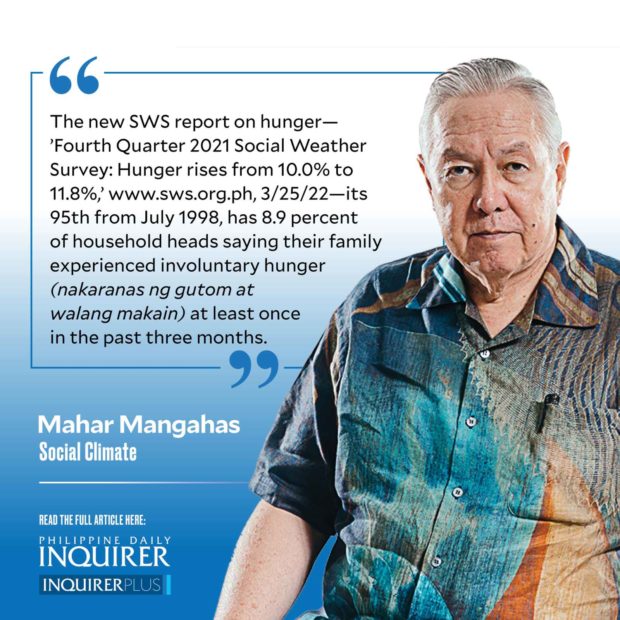95 hunger surveys since 1998
The new SWS report on hunger—“Fourth Quarter 2021 Social Weather Survey: Hunger rises from 10.0% to 11.8%,” www.sws.org.ph, 3/25/22—its 95th from July 1998, has 8.9 percent of household heads saying their family experienced involuntary hunger (nakaranas ng gutom at walang makain) at least once in the past three months.
In the past 24 years (1998-2021), the national hunger rate ranged from a low of 5.1 percent (2003Q3) to a catastrophic, lockdown-affected, peak of 30.7 percent (2020Q3) of all families (presently 25 million) in the nation.
Article continues after this advertisementThe annual average ranged between 7.0 percent in 2003 and 21.1 percent in 2020. The 2021 average was 13.1 percent, a big relief from 2020, but still well over the pre-pandemic 2019 average of 9.3 percent, which had been the lowest since 2004.
Like Self-Rated Poverty, the SWS hunger indicator counts families, not individuals. It is likewise measured bottom-up, from the families’ direct experience of hunger, rather than by counting the family’s calories, nutrients or meals relative to some norms.
SWS tracks the degree of hunger from household heads’ responses about the frequency of experiencing it: calling it moderate for those saying it only happened once or a few times, and severe for those saying it happened often or always. The 11.8 total percentage of December 2021 was 9.2 points moderate hunger plus 2.6 points severe hunger.
Article continues after this advertisementEnding poverty and hunger are No.1 and No.2, respectively, of the United Nations’ Sustainable Development Goals (SDGs). They are much more meaningful than the gross national product per capita, in measuring economic performance over time.
Poverty and hunger are related, yet different. The two are separately important; hence they occupy two SDGs. When probed in the same survey, the respondents can easily distinguish them. Not all of the poor go hungry; but hunger is always more common among them than among the nonpoor (i.e. the combined Not Poor and Borderline Poor). Hunger also happens to some of the nonpoor, but it is not as common as among the poor.
From one quarter to the next, the percentages of the hungry change, among both the poor and the nonpoor. From 2021Q3 to 2021Q4, hunger among the poor rose by over 3 points, from 14.3 percent to 17.6 percent, while hunger among the nonpoor rose by 1 point, from 6.5 to 7.5 percent. (Presumably, the main factor was food price inflation; this can be quantified by statistical analysis.)
The net result was that hungry families rose by 1.8 points, from 10.0 percent in 2021Q3 to 11.8 percent in 2021Q4, even though Self-Rated Poor families fell by 2 points, from 45 percent to 43 percent, from Q3 to Q4. It’s not the first time for hunger and poverty to move in opposite directions in the course of three months.
However, in the course of the whole year 2021, compared to 2020, the hunger and poverty rates both fell. (We don’t know the full extent of the fall in poverty, since SWS face-to-face surveying restarted only in 2020Q4.)
Of the four SWS survey areas, Metro Manila often has the most hunger and the least poverty at the same time. In 2021Q4, the National Capital Region (NCR) had 22.8 percent hungry and 25 percent poor; Balance Luzon had 9.2 percent hungry and 41 percent poor; the Visayas had 9.7 percent hungry and 60 percent poor; and Mindanao had 12.2 percent hungry and 43 percent poor. The obvious reason is because families in NCR have much less opportunity to grow or raise their own food at home.
For the full year 2021, the average hunger/poverty percentages in each area were: 16.4/35 in NCR; 12.8/41 in Balance Luzon; 10.1/60 in the Visayas; and 14.6/53 in Mindanao. Note that, in 2021, the Visayas had the least hunger and yet the most poverty, at the same time.
The SWS mission. SWS regularly generates scientific data about the quality of life of the Filipino people, with the quarterly Social Weather Survey as its main vehicle. It aims to reach the public in general and the scientific community in particular. In recognition of its work, it received the International Society for Quality of Life Studies (www.isqols.org) 2019 Award for the Betterment of the Human Condition.
——————
Contact: mahar.mangahas@sws.org.ph

















